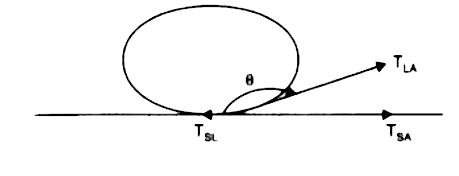Explain why
(a). The angle of contact of mercury with galss is obtuse, while that of water with glass is acute.
(b). Water on a clean glass surface tends to spread out while mercury on the same surface tends to form drops. (Put differently, water wets glass while mercury does not).
(c). Surface tension of a liquid is independent of the area of the surface
(d). Water with detergent disolved in it should have small angles of contact.
(e). A drop of liquid under no external forces is always spherical in shape.

(a). Let a drop of a liquid L be poured on a solid surface S placed in air A. if TSL and TSA be the surface tensions corresponding to solid-liquid layer, liquid-air layer and solid-air layer respectively and θ be the angle of contact between the liquid and solid then,
TLACθ+TSL=TSA
⇒cosθ=TSA−TSL/TLA
for the mercury-glass interfere, TSA<TSL. therefore, cos0 is negative. thus θ is an obtuse angle. for the water-glass interface TSA>TSL. therefore cos0 is positive. thus, θ is an acute angle.
(b). Water on a clean glass surface tends to spread out i.e., watedr wets glass because force f cohesion of water is much less than the force of adhesion due to glass. in case of mercury force of cohesion due to mercury molecules is quite strong as compared to adhesion force due to glass. consequently, merucry does not wet glass and tends to form drops.
(c). Surface tensio f liquid i the force acting per unit length on a line drawn tangentially to the liquid surface at rest. since h as force is independent of the area of liquid surface therefore, surface tension is also independent of the area of the liquid surface.
(d). We know that the clothes have narrow pores or spaces which act as capillaries. also, we know that the rise of liqud in a capillary tue is directly proportional to cosθ (Here θ is the angle of contact). As θ is small for detergent, therefore cosθ will be large. due to this, the dentergent will penetrate more in the narrow pores of the clothes.
(e). We know that any system tends to remain in a state of minimum energy. in the absence of any external force for a given volume of liquid its surface area and consequently. surface energy is least for a spherical shape. it is due to this reaso that a liquid drop, in the absence of an external force is spherical in shape.
Topper's Solved these Questions
- BOOK - NCERTCHAPTER - MECHANICAL PROPERTIES OF FLUIDSEXERCISE - EXERCISE31videos
MECHANICAL PROPERTIES OF FLUIDS
- BOOK - NCERTCHAPTER - LAWS OF MOTION EXERCISE - EXERCISE40videos
LAWS OF MOTION
- BOOK - NCERTCHAPTER - MECHANICAL PROPERTIES OF SOLIDSEXERCISE - EXERCISE21videos
MECHANICAL PROPERTIES OF SOLIDS
Similar Questions
Explain why: Surface tension of a liquid is independent of the area of the surface.
View SolutionExplain why
(a). The angle of contact of mercury with galss is obtuse, while that of water with glass is acute.
(b). Water on a clean glass surface tends to spread out while mercury on the same surface tends to form drops. (Put differently, water wets glass while mercury does not).
(c). Surface tension of a liquid is independent of the area of the surface
(d). Water with detergent disolved in it should have small angles of contact.
(e). A drop of liquid under no external forces is always spherical in shape.View Solution
Knowledge Check
- Question 1 - Select One
The angle of contact of mercury glass surface is
A0∘B80∘C120∘D135∘ - Question 2 - Select One
The angle of contanct between glass and mercury is
A0∘B30∘C90∘D135∘ - Question 3 - Select One
The surface of water in contact with glass wall is
AplaneBconcaveCconvexDboth (B) and (c )
Water meniscus in a glass tube is concave while that of mercury is convex. Why ?
View SolutionMercury does not wet glass. This is the property of liquid known as
View SolutionA liquid does not wet solid surface if angle of contact is
View SolutionA liquid does not wet solid surface if angle of contact is
View SolutionThe angle of contact for pure water and clean glass surface is
View Solution

